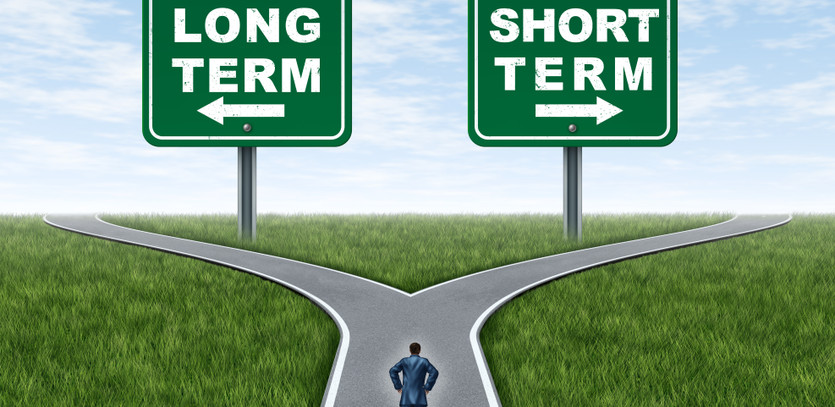Navigating the vast sea of investment options can feel like traversing an intricate maze. It's a journey with numerous crossroads, each leading to different potential outcomes that ultimately shape your financial future. Among the most critical decisions you need to make is determining the perfect balance between long-term and short-term investments.
The significance of this decision cannot be overstated. It's akin to planting a seed in a garden, where you must decide between a fast-growing annual that provides quick but temporary bloom, or a slow-maturing perennial that takes time to flourish but promises years of recurring beauty. Each comes with its own merits and trade-offs.
The Ideal Investment Horizon: Long-term vs Short-term
In the world of investments, short-term instruments can be likened to annuals in your garden. They mature quickly, providing faster access to returns that could fulfill immediate or near-term financial needs. However, like annual plants, the rewards are often smaller and more fleeting, as these investments do not have the luxury of time to compound and substantially grow.
On the other hand, long-term investments, much like perennials, are slow and steady. They are meant for goals that lie several years, even decades ahead, and require a patient and committed gardener—or in this case, an investor. These instruments have the advantage of time, allowing interest to compound, and potentially offering a higher yield over the long run. However, they also come with more uncertainty and are typically more exposed to market volatilities.
Essentially, selecting between long-term and short-term investments is not a matter of deciding which one is objectively better. Rather, it's about understanding your financial landscape—identifying your objectives, determining your risk tolerance, and setting a timeline for your goals. This article will guide you in making these vital decisions by revealing the strengths and weaknesses of both investment horizons, helping you design the most fruitful investment garden tailored to your unique needs and aspirations.
Opting for Long-term Investments: When and Why
Long-term investments refer to assets that are held onto for extended periods.
According to Wendy Liebowitz, vice president of Fidelity Investments’ Fort Lauderdale branch, long-term assets such as stocks or real estate, are typically held for substantial periods. These investments can stimulate growth in your portfolio, as they won't be liquidated for a considerable duration.
Certain circumstances may encourage you to consider long-term investments.
The Retirement Countdown: Over 20 Years To Go
If your retirement is still more than twenty years away, you have a significant time span to capitalize on the growth potential of long-term investments such as stocks.
As Liebowitz highlights, "Younger investors have the advantage of time on their side to recover from potential market downfalls. Using stocks can be a useful strategy to accumulate wealth for the future. As retirement approaches, you can reassess and diversify your asset allocation.”
Planning for Mid-Term Financial Goals: Seven to Ten Years Ahead
Financial plans that span the next seven years generally encompass portfolios with low to medium risk. However, when planning for seven to ten years in the future, you might need to contemplate riskier assets, according to David Stein, a former fund manager and author of “Money for the Rest of Us.”
“Typically, for funds you won't require immediately, long-term investments such as stocks are suitable. The investment horizon is a crucial factor,” Stein notes. He further suggests dividend stocks as a feasible option for mid-term objectives that can benefit from regular payouts and potential growth.
Safeguarding Against Inflation
Long-term investments may also be the right choice when your objective is to outrun inflation or seek protection against it. As long-term investments like stocks usually present more risk than other assets, they can potentially offer higher returns over time, safeguarding your purchasing power.
Stein also suggests the purchase of I-bonds, Treasury bonds which offer a fixed yield and an inflation adjustment. Although they may not suffice as a standalone retirement fund, they can complement a long-term investment strategy.
Choosing Short-Term Investments: The Right Circumstances
Conversely, short-term investments are assets that are typically utilized for financial objectives within a closer timeframe, as Liebowitz elucidates. These could include bonds, cash, and annuities, often used as a reliable income source rather than a portfolio-building tool.
There are certain situations where short-term investments may be the optimal choice.
Near-Term Financial Needs
When saving for near-term objectives, such as a home down payment, short-term investments can be advantageous. Certain deposit accounts, for instance, offer a predictable return and easy withdrawal when needed.
Liebowitz comments, “These asset types are generally seen as lower risk. Assets like money market mutual funds or short-term bonds allow easy access to funds for immediate goals without the fear of market loss.”
Seeking Regular Income
Short-term investments can often provide a steady income. Hence, if you require consistent income, shifting towards assets such as highly-rated bonds can be beneficial.
Liebowitz notes, “In some cases, annuities can provide regular income for short-term needs, although they are not suitable for everyone and come with their own set of advantages and disadvantages.”
Reflections and Key Takeaways: Unraveling the Investment Puzzle
Investing, like any intricate art, requires you to weave together an array of elements, each bringing its unique color and texture to the tapestry of your financial future. The dance between long-term and short-term investments is one such elegant performance in this grand ballet of wealth creation.
Understanding that long-term investments, similar to mighty oaks, require time to reach their full potential is crucial. They may sway in the market's tempestuous winds, but given time, they promise significant growth and are suited for future-oriented goals.
Conversely, short-term investments act as sturdy shrubs in your financial garden. They may not touch the skies, but they provide near-term returns, catering to immediate needs. Though their growth might be limited, they offer a safety net in the face of market turbulence.
Harmony, however, is found in balance. A wise investor, like a seasoned gardener, understands the value of diversity. A well-tended garden, much like a robust portfolio, thrives with a mix of both oaks and shrubs, long-term and short-term investments. Each serves its purpose, balancing risk and return to cultivate a landscape of growth and stability.
As we pull the curtain on this exploration, let's leave no stone unturned by addressing some common queries in our quest to unravel the enigma of investment strategies.
What are growth stocks? Growth stocks are akin to exotic, rare plants in your garden. These are shares in a company anticipated to grow at a pace above the market average. Usually, these stocks don't offer dividends as the companies plow back their earnings for continuous expansion and growth.
What are index funds? Think of index funds as a well-balanced fertilizer mix for your financial garden. They are mutual funds or ETFs that aim to mimic a particular financial index such as the S&P 500, the Nasdaq Composite, or the Dow Jones Industrial Average. These funds offer diversity and have low operating expenses, hence becoming a popular choice for nourishing retirement portfolios such as IRAs and 401(k)s.
By mastering the dance between long-term and short-term investments and understanding the nuances of growth stocks and index funds, you're well on your way to cultivating a thriving investment garden, promising a prosperous financial future.





